MATHEMATICS 2009
Set III - Outside Delhi
Set III - Outside Delhi
Questions number 1 to 10 carry 1 mark each.
Q. 1. What is the exponent of 3 in the prime factorization of 864?
Ans. Exponent of 3 is 3
Sol.
864 = 25 x33
 Exponent of 3 is 3
Exponent of 3 is 3
Q. 2. The graph of the polynomial y = ax2 + bx + c is shown in Fig. 1. Write the value of b2 – 4ac
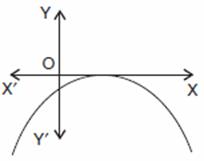
Ans .
b2 – 4ac = 0
y = ax2 + bx + c
Sol.2. The graph touches the x-axis at one point onlyy = ax2 + bx + c
 Value of b2 – 4ac = 0
Value of b2 – 4ac = 0Q. 3. Write the values of k for which the quadratic equation x2 – kx + 9 = 0 has equal roots.
Ans. k =  6
6
 6
6 Sol. 3. Here ‘a’= 1, b = – k, c = 9
D = 0 …(Equal roots)
 b2 – 4ac = 0
b2 – 4ac = 0
 (– k)2 – 4(1) (9) = 0
(– k)2 – 4(1) (9) = 0  k2 – 36 = 0
k2 – 36 = 0
 k2 = 36
k2 = 36  k =
k =  6
6
D = 0 …(Equal roots)
 b2 – 4ac = 0
b2 – 4ac = 0 Q. 4. Write the common difference of an A.P. whose nth term is 3n + 5.
Ans . 3
Sol. nth term, an= 3n + 5
When n = 1, a1 = 3(1) + 5 = 8
When n = 2, a2 = 3(2) + 5 = 11
 Common difference, d = a2 – a1 = 11 – 8 = 3
Common difference, d = a2 – a1 = 11 – 8 = 3
When n = 1, a1 = 3(1) + 5 = 8
When n = 2, a2 = 3(2) + 5 = 11
Q. 5. Write the value of

Ans . – 5
Sol.
 .
.= 5 tan2 - 5 sec2
- 5 sec2 
= -5(sec2 - 5 tan2
- 5 tan2 ) =-5 (1) = -5
) =-5 (1) = -5
 - 5 sec2
- 5 sec2 
= -5(sec2
 - 5 tan2
- 5 tan2 ) =-5 (1) = -5
) =-5 (1) = -5 Q. 6. In Fig. 2, ST || QR, PS = 2 cm and SQ = 3 cm. What is the ratio of the area of  PQR to the area of
PQR to the area of  PST?
PST?
 PQR to the area of
PQR to the area of  PST?
PST?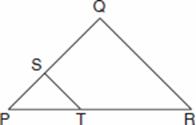
Ans. 25 : 4
Sol.  PQR and
PQR and  PST
PST
 PQR and
PQR and  PST
PST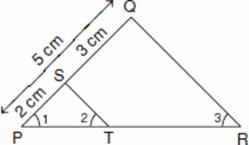

 POB = 115°, then find
POB = 115°, then find  APO.
APO.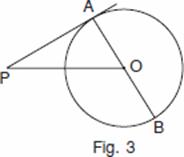
Ans. APO = 25°
Sol.

Q. 8. The length of a minor arc is 2/9 of the circumference of the circle. Write the measure of the angle subtended by the arc at the centre of the circle.
Ans : 80°
Soln. Length of a minor arc
=2/9circumferenceof a circle …….(Given
=2/9circumferenceof a circle …….(Given
Q. 9. Find the product of HCF and LCM of numbers 50 and 95. 1
Sol . Product = 4750Q. 10. The diameter of the base of a cone is 14 cm and its slant height is 25 cm. What is its vertical height? 1
Sol. Vertical height = 24 cm
WORKINGS
Complete solutions to the questions of Section A
are being given for your reference only.
are being given for your reference only.
SECTION B
Questions number 11 to 15 carry 2 marks each.
Q. 11. What real number should be subtracted from the polynomial 3x3 + 10x2 – 14x + 9 so that the polynomial 3x – 2 divides it exactly?
Sol.
Q. 13. Find a relation between x and y if the points (2, 1), (x, y) and (7, 5) are collinear.
Sol .
Let A(2, 1), B(x, y) and C(7, 5) Pts. A, B, C are collinear … (Given)
 2(y – 5) + x(5 – 1) + 7(1 – y) = 0
2(y – 5) + x(5 – 1) + 7(1 – y) = 0
 2y – 10 + 5x – 5 + 7 – 7y = 0
2y – 10 + 5x – 5 + 7 – 7y = 0
 5x – 5y – 8 = 0
5x – 5y – 8 = 0
or
5x – 5y = 8
Let A(2, 1), B(x, y) and C(7, 5) Pts. A, B, C are collinear … (Given)
 2(y – 5) + x(5 – 1) + 7(1 – y) = 0
2(y – 5) + x(5 – 1) + 7(1 – y) = 0 2y – 10 + 5x – 5 + 7 – 7y = 0
2y – 10 + 5x – 5 + 7 – 7y = 0 5x – 5y – 8 = 0
5x – 5y – 8 = 0 or
5x – 5y = 8
Q. 14. ABC is an equilateral triangle with side 2a. Find the length of one of its altitudes. 2
Sol .Q. 15.
Sol .
SECTION C
Questions number 16 to 25 carry 3 marks each.
Q. 16. Prove that  is an irrational number.
is an irrational number.Sol. See Q. 16, 2009
Q. 17. Find all other zeroes of x4 + x3– 23x2 – 3x + 60, if it is given that two of its zeroes are and –
and –  .
.Sol. Since two zeroes are  and – .
and – . (x –
(x –  ) (x +
) (x +  ) = x2 – 3 is a factor of given polynomial.
) = x2 – 3 is a factor of given polynomial.
 x4 + x3–23x2– 3x + 60
x4 + x3–23x2– 3x + 60
= (x2 – 3) (x2 + x – 20)
= (x2 – 3) (x2 + 5x – 4x – 20)
= (x2 – 3) [x(x + 5) – 4(x + 5)]
= (x + 3 )(x – 3 )(x – 4)(x + 5)
All other zeroes are x – 4 = 0 or x + 5 = 0
x = 4 or x = – 5
 and – .
and – . (x –
(x –  ) (x +
) (x +  ) = x2 – 3 is a factor of given polynomial.
) = x2 – 3 is a factor of given polynomial. x4 + x3–23x2– 3x + 60
x4 + x3–23x2– 3x + 60= (x2 – 3) (x2 + x – 20)
= (x2 – 3) (x2 + 5x – 4x – 20)
= (x2 – 3) [x(x + 5) – 4(x + 5)]
= (x + 3 )(x – 3 )(x – 4)(x + 5)
All other zeroes are x – 4 = 0 or x + 5 = 0
x = 4 or x = – 5
Q. 18. Check graphically whether the pair of equations 3x – 2y + 2 = 0 and  x – y + 3 = 0, is consistent. Also find the coordinates of the points where the graphs of the equations meet the y-axis.
x – y + 3 = 0, is consistent. Also find the coordinates of the points where the graphs of the equations meet the y-axis.
 x – y + 3 = 0, is consistent. Also find the coordinates of the points where the graphs of the equations meet the y-axis.
x – y + 3 = 0, is consistent. Also find the coordinates of the points where the graphs of the equations meet the y-axis.Sol. 3x – 2y + 2 = 0  x – y + 3 = 0
x – y + 3 = 0
 3x + 2 = 2y
3x + 2 = 2y  x + 3 = y
x + 3 = y


 x – y + 3 = 0
x – y + 3 = 0 3x + 2 = 2y
3x + 2 = 2y  x + 3 = y
x + 3 = y

| x | 0 | 2 | -2 |
| y | 1 | 4 | -2 |
| x | 0 | 2 | -2 |
| y | 3 | 6 | 0 |
By plotting the points and joining them, the lines do not intersect anywhere, i.e., they are parallel.
 Given pair of equations is not consistent, i.e., inconsistent.
Given pair of equations is not consistent, i.e., inconsistent.
 The equation 3x – 2y + 2 = 0 meets the y-axis at A(0, 1)
The equation 3x – 2y + 2 = 0 meets the y-axis at A(0, 1)
The equation x – y + 3 = 0 meets the y-axis at B(0, 3).
x – y + 3 = 0 meets the y-axis at B(0, 3).
 Given pair of equations is not consistent, i.e., inconsistent.
Given pair of equations is not consistent, i.e., inconsistent. The equation 3x – 2y + 2 = 0 meets the y-axis at A(0, 1)
The equation 3x – 2y + 2 = 0 meets the y-axis at A(0, 1) The equation
 x – y + 3 = 0 meets the y-axis at B(0, 3).
x – y + 3 = 0 meets the y-axis at B(0, 3).Or
A fraction becomes  , if 2 is added to both numerator and denominator. If 3 is added to both numerator and denominator, it becomes
, if 2 is added to both numerator and denominator. If 3 is added to both numerator and denominator, it becomes . Find the fraction.
. Find the fraction.Sol. Let the fraction by

According to the question

3x + 6 = y + 2
3x – y = 2 – 6
3x – y = –4
3x + 4 = y …(i)
3x – y = 2 – 6
3x – y = –4
3x + 4 = y …(i)

5x + 15 = 2y + 6
5x – 2y = 6 – 15
5x – 2y = – 9
5x – 2(3x + 4) = – 9
…[From (i)
5x – 6x – 8 = – 9
– x = – 9 + 8
– x = – 1
x = 1
From (i), y = 3(1) + 4 = 7
 The fraction =
The fraction =  =
= 
5x – 2y = 6 – 15
5x – 2y = – 9
5x – 2(3x + 4) = – 9
…[From (i)
5x – 6x – 8 = – 9
– x = – 9 + 8
– x = – 1
x = 1
From (i), y = 3(1) + 4 = 7
 The fraction =
The fraction =  =
= Q. 19. Find the middle term of the A.P. 10, 7, 4, …, (– 62) .
Sol. 1 st term, a = 10
Common difference, d = 7 – 10 = – 3
an = – 62
 a + (n – 1)d = – 62
a + (n – 1)d = – 62
 10 + (n – 1) (– 3) = – 62
10 + (n – 1) (– 3) = – 62
 (n – 1) (– 3) = – 62 – 10 = – 72
(n – 1) (– 3) = – 62 – 10 = – 72
 n – 1 =
n – 1 = = 24
= 24
 n = 24 + 1 = 25
n = 24 + 1 = 25
Common difference, d = 7 – 10 = – 3
an = – 62
 a + (n – 1)d = – 62
a + (n – 1)d = – 62 10 + (n – 1) (– 3) = – 62
10 + (n – 1) (– 3) = – 62 (n – 1) (– 3) = – 62 – 10 = – 72
(n – 1) (– 3) = – 62 – 10 = – 72 n – 1 =
n – 1 = = 24
= 24  n = 24 + 1 = 25
n = 24 + 1 = 25Middle term =  term
term  term=13th term
term=13th term
 term
term  term=13th term
term=13th terman = a + (n – 1)d  a13 = a + 12d
a13 = a + 12d
 a13 = 10 + 12(– 3) = 10 – 36 = – 26
a13 = 10 + 12(– 3) = 10 – 36 = – 26
 a13 = a + 12d
a13 = a + 12d a13 = 10 + 12(– 3) = 10 – 36 = – 26
a13 = 10 + 12(– 3) = 10 – 36 = – 26Q. 20. For an acute angle  show that
show that
 show that
show that(sin  – cosec
– cosec  ) (cos
) (cos  – sec
– sec  ) =
) = 
 – cosec
– cosec  ) (cos
) (cos  – sec
– sec  ) =
) = 
Sol. LHS = (sin  – cosec
– cosec ) (cos
) (cos  – sec
– sec  )
)
=
=
=

=
 – cosec
– cosec ) (cos
) (cos  – sec
– sec  )
)=

=

=


=

RHS=

=

= …..[
…..[ cos2
cos2 +sin2
+sin2 = 1]
= 1]
 …..[
…..[ cos2
cos2 +sin2
+sin2 = 1]
= 1]= cos + sin
+ sin …(ii)
…(ii)
 + sin
+ sin …(ii)
…(ii)From (i) and (ii) LHS = RHS

AP : PB = 1 : 4
P

=
AR:RB=3:2

AR:RB=3:2
R
=

=

Q. 22. A (– 4, – 2), B(– 3, – 5), C(3, – 2) and D(2, k) are the vertices of a quadrilateral ABCD. Find the value of k, if the area of the quadrilateral is 28 sq. units.
Sol.
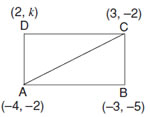

ar( ABC)
ABC)
 ABC)
ABC)=  + (-3)[ -2 – (-2 )] + 3[ -2-(-5)] (-4 , -2)
+ (-3)[ -2 – (-2 )] + 3[ -2-(-5)] (-4 , -2)
 + (-3)[ -2 – (-2 )] + 3[ -2-(-5)] (-4 , -2)
+ (-3)[ -2 – (-2 )] + 3[ -2-(-5)] (-4 , -2)= -3 (-2+2 + 3 (-2 + 5) ]
-3 (-2+2 + 3 (-2 + 5) ]
 -3 (-2+2 + 3 (-2 + 5) ]
-3 (-2+2 + 3 (-2 + 5) ]= -3(0) + 3 (3 ) ]
-3(0) + 3 (3 ) ]
 -3(0) + 3 (3 ) ]
-3(0) + 3 (3 ) ]=

ar ( ABC)ar(
ABC)ar( ABD) =28
ABD) =28
 + ar (
+ ar ( ACD)= 28
ACD)= 28
 ABC)ar(
ABC)ar( ABD) =28
ABD) =28 + ar (
+ ar ( ACD)= 28
ACD)= 28 ar ( ACD) =28 -
ACD) =28 -  =
=  =
=

 [-4(-2-k) + 3 (k- (-2)) + 2(-2-(-2))] =
[-4(-2-k) + 3 (k- (-2)) + 2(-2-(-2))] = 

 8 + 4k + 3k + 6 = 35
8 + 4k + 3k + 6 = 35
 7k + 14 = 35
7k + 14 = 35
 k + 2 = 5 …(Dividing both sides by 7)
k + 2 = 5 …(Dividing both sides by 7)
 k =
k =  5 – 2
5 – 2
 k = 5 – 2 or k = – 5 – 2
k = 5 – 2 or k = – 5 – 2
 k = 3 or k = – 7
k = 3 or k = – 7
 ACD) =28 -
ACD) =28 -  =
=  =
=
 [-4(-2-k) + 3 (k- (-2)) + 2(-2-(-2))] =
[-4(-2-k) + 3 (k- (-2)) + 2(-2-(-2))] = 
Q. 23. In Fig. 4, AB is a chord of length 9.6 cm, of a circle with centre O and radius 6 cm. The tangents at A and B intersect at P. Find the length of PA.
Sol. Join OP. Let it intersect AB at point M.
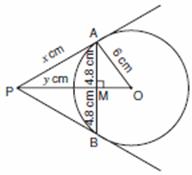
Then  PAB is an isosceles
PAB is an isosceles  and PO is the angle bisector of
and PO is the angle bisector of  APB
APB
So, OP AB and therefore, OP bisects AB which gives
AB and therefore, OP bisects AB which gives
 PAB is an isosceles
PAB is an isosceles  and PO is the angle bisector of
and PO is the angle bisector of  APB
APB So, OP
 AB and therefore, OP bisects AB which gives
AB and therefore, OP bisects AB which givesAM=MB=
Also OAP=900………….
OAP=900…………. 
In rt. AMO,OM=
AMO,OM=
=
=
=

Also
 OAP=900………….
OAP=900…………. 
In rt.
 AMO,OM=
AMO,OM=
=

=

=

LetPA =xcm and PM = Y cm
In rt AMP, x2 = y2 + (4.8)2 (Pythagoras’ theorem)
AMP, x2 = y2 + (4.8)2 (Pythagoras’ theorem)
X2= y2 + 23.04 …(i)
In rt. ΔPAO, OP2 = PA2 + AO2
…(Pythagoras’ theorem)
(y + 3.6) 2= x2 + (6) 2
In rt
 AMP, x2 = y2 + (4.8)2 (Pythagoras’ theorem)
AMP, x2 = y2 + (4.8)2 (Pythagoras’ theorem)X2= y2 + 23.04 …(i)
In rt. ΔPAO, OP2 = PA2 + AO2
…(Pythagoras’ theorem)
(y + 3.6) 2= x2 + (6) 2
y2 + (3.6) 2 + 2(y) (3.6) = y2 + 23.04 + 36 …[From (i)]
12.96 + 7.2y = 59.04
12.96 + 7.2y = 59.04
7.2y = 59.04 – 12.96 = 46.08


From(i),x2 = y 2+23.04
=(6.4)2+23.04
=40.96+23 .04 = 64
 Tangent, PA ,x =
Tangent, PA ,x = =+8 cm
=+8 cm
=(6.4)2+23.04
=40.96+23 .04 = 64
 =+8 cm
=+8 cmQ. 24. Obtain all other zeroes of x4+ 4x3– 2x2– 20x – 15, if two of its zeroes are
Sol . √5 and -√5
Q. 25. Find the coordinates of the points of trisection of the line segment joining the points A(– 5, 6) and B(4, – 3).
SECTION D
Questions number 26 to 30 carry 6 marks each.
Q. 26 A motorboat whose speed in still water is 5 km/h, takes 1 hour more to go 12 km upstream
than to return downstream to the same spot. Find the speed of the stream.
than to return downstream to the same spot. Find the speed of the stream.
Q. 27. A man on the deck of a ship 14 m above water level, observes that the angle of elevation ofthe top of a cliff is 60° and the angle of depression of the base of the cliff is 30°. Calculate the distance of the cliff from the ship and the height of the cliff. [Take 3 = 1.732]
Or
The angles of depression of the top and the bottom of a 9 m high buildling from the top of a tower are 30° and 60° respectively. Find the height of the tower and the distance between the building and the tower.
Q. 28. Prove that, in a triangle, if the square on one side is equal to the sum of squares of the other two sides, then the angle opposite to the first side is a right angle. Using the above, show that in an isosceles triangle ABC with AC = BC, if AB2 = 2AC2 then ABC is a right triangle.
Sol. Part I : See Theorem
Part II : AB2 = 2AC2
…(Given)
AB2 = AC2 + AC2
AB2 = AC2 + BC2
…[AC = BC (given)]
Or
Prove that the lengths of tangents drawn from an external point to a circle are equal. Use the above result in the following :A circle is inscribed in a ΔABC, touching AB, BC and AC at P, Q and R
respectively, as shown in
respectively, as shown in
Fig. 7. If AB = 10 cm,
AR = 7 cm and RC = 5
cm, then find the length of BC.
AR = 7 cm and RC = 5
cm, then find the length of BC.
Sol.
Part I : See Theorem
Part II : AP = AR = 7 cm …(Given theorem)
QC = RC = 5 cm …(Given theorem)
BP = AB – AP
= 10 – 7 = 3 cm
BQ = BP = 3 cm …(Given theorem)
 BC = BQ + QC = 3 + 5 = 8 cm
BC = BQ + QC = 3 + 5 = 8 cm
QC = RC = 5 cm …(Given theorem)
BP = AB – AP
= 10 – 7 = 3 cm
BQ = BP = 3 cm …(Given theorem)
Q. 29. The age of a father is twice the square of the age of his son. Eight years hence, the age of the father will be 4 years more than three times the age of his son. Find their present ages. 6
Sol: Let the present age of Son = x years and the present age of Father = 2x2years According to the problem
Q. 30. A wooden article was made by scooping out a hemisphere from each end of a solid cylinder, as shown in Fig.8. If the height of the cylinder is 12 cm and its base is of radius 4.2 cm, find the total surface area of the article. Also find the volume of wood left in the article.
Use :Pie = 22/7
(ii) Volume of wood left in the article
= Vol. of cyl. – 2(Vol. of hemisphere)
= Vol. of cyl. – 2(Vol. of hemisphere)


















No comments:
Post a Comment